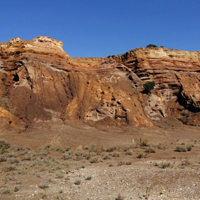Innovative amendments derived from industrial and municipal wastes enhance plant growth and soil functions in potentially toxic elements-polluted environments

Accepted: 20 March 2021
PDF: 556
All claims expressed in this article are solely those of the authors and do not necessarily represent those of their affiliated organizations, or those of the publisher, the editors and the reviewers. Any product that may be evaluated in this article or claim that may be made by its manufacturer is not guaranteed or endorsed by the publisher.
Potentially toxic elements (PTE), e.g. As, Sb, Cd, Cu, Pb, Zn, can severely impact soil element cycling, organic matter turnover and soil inhabiting microbiota. Very often this has dramatic consequences for plant growth and yield which are greatly restricted in PTE-contaminated soils. The use of innovative amendments to reduce the labile pool of such soil contaminants, can result as a feasible and sustainable strategy to improve the fertility and functionality of PTE-contaminated soils as well as to exploit these latter from an agronomic point of view. Water treatment residuals (WTR), red muds (RM), organic-based materials originating from the waste cycle, e.g. municipal solid waste compost (MSWC) and biochar (BCH), have emerged in the last decades as promising amendments. In this paper, we report a synthesis of the lessons learned from research carried out in the last 20 years on the use of the above-mentioned innovative amendments for the manipulation of soil fertility and functionality in PTE-contaminated soils. The amendments considered possess physico-chemical properties useful to reduce labile PTE in soil (e.g. alkaline pH, porosity, Fe/Al phases, specific functional groups and ionic composition among the others). In addition, they contain organic and inorganic nutrients which can contribute to improve the soil chemical, microbial and biochemical status. This is often reflected by a higher organic matter content in amended soils and/or an increase of the cation exchange capacity, available P and total N and/or dissolved organic C. As a result, soil microbial abundance, in particular heterotrophic fungi and bacteria, and enzyme activities (e.g. dehydrogenase, urease and β-glucosidase) are commonly enhanced in amended soils, while plant growth can be significantly stimulated. Overall, the obtained results suggest that the studied amendments can be used to reduce PTE bioavailability in polluted soils, improve soil microbial status and functionality, and enhance the productivity of different crops. This can offer a precious opportunity for the productive recovery of PTE-polluted soils.
Highlights
- Water treatment residuals, red muds, municipal solid waste compost and biochar can reduce labile PTE in contaminated soils.
- When used as amendments, WTR, RM, MSWC and BCH improve soil chemical fertility of PTE-polluted soils.
- WTR, RM, MSWC and BCH stimulate soil enzyme activity and heterotrophic bacterial abundance in PTE-polluted soils.
- WTR, RM, MSWC and BCH can be used as strategic amendments to enhance plant growth in environments polluted by PTE.
How to Cite

This work is licensed under a Creative Commons Attribution-NonCommercial 4.0 International License.
PAGEPress has chosen to apply the Creative Commons Attribution NonCommercial 4.0 International License (CC BY-NC 4.0) to all manuscripts to be published.

 https://doi.org/10.4081/ija.2021.1777
https://doi.org/10.4081/ija.2021.1777



